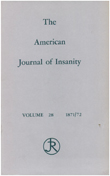Predicting the "revolving door" phenomenon among patients with schizophrenic, schizoaffective, and affective disorders
Abstract
OBJECTIVE: A subpopulation of chronically mentally ill patients, sometimes referred to as "revolving door" patients, are frequently readmitted to psychiatric units. This study examined the relationships among demographic features, diagnostic characteristics, and frequency of hospitalization of patients from four state hospitals. METHOD: Two semistructured, standardized instruments, the Schedule for Affective Disorders and Schizophrenia and a life events history, were administered to 135 inpatients who met the Research Diagnostic Criteria for schizophrenia (N = 56), schizoaffective disorder (N = 33), unipolar major depressive disorder (N = 23), and bipolar disorder (N = 23). Criminal history was assessed by arrest records. The main outcome measure was the number of hospitalizations. RESULTS: Chi-square and trend test analyses indicated that substance abuse and noncompliance with medication regimens were significantly associated with higher frequencies of hospitalization. A multiple regression model, which included alcohol/drug problems, medication noncompliance, and six sociodemographic and diagnostic variables (age, gender, race, marital status, years of education, and diagnosis) accounted for a significant proportion of the ability to predict frequency of hospitalization. Half of this predictability was due to the relationship of substance abuse and medication noncompliance with number of hospitalizations. CONCLUSIONS: Alcohol/drug problems and noncompliance with medication were the most important factors related to frequency of hospitalization. Preventing these behaviors through patient education may reduce rehospitalization rates.
Access content
To read the fulltext, please use one of the options below to sign in or purchase access.- Personal login
- Institutional Login
- Sign in via OpenAthens
- Register for access
-
Please login/register if you wish to pair your device and check access availability.
Not a subscriber?
PsychiatryOnline subscription options offer access to the DSM-5 library, books, journals, CME, and patient resources. This all-in-one virtual library provides psychiatrists and mental health professionals with key resources for diagnosis, treatment, research, and professional development.
Need more help? PsychiatryOnline Customer Service may be reached by emailing [email protected] or by calling 800-368-5777 (in the U.S.) or 703-907-7322 (outside the U.S.).



